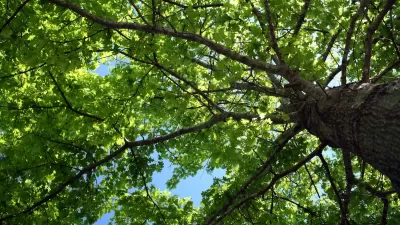Far from just providing shade and improving air quality, trees can also contribute to more resilient roads, lower energy costs, and reduced flood risk.

In a piece on Strong Towns, Emma Durand-Wood extols the many benefits of urban trees, which contribute to everything from cooler temperatures to cleaner air to higher property values.
Money talks. While the critical environmental benefits that trees provide (like capturing carbon, cleaning the air and supporting biodiversity) have tremendous and calculable value, advocating for trees on an environmental basis isn’t always effective.
To that end, Durand-Wood outlines some of the tangible, economic benefits of street trees. These include, surprisingly, longer lasting roads: “street trees prolong the life of road surfaces by keeping them cooler and reducing temperature fluctuations.” According to one study, the amount of shade on a street is directly correlated to the length of time needed between repaving treatments.
Another benefit: less flooding, since “A mature tree can intercept 30%-40% of rainfall before it even hits the ground.” Trees also create more comfortable and safe walking and biking conditions, provide shade at bus stops and in public spaces, and help reduce cooling bills by lowering surrounding air temperature.
Durand-Wood concludes, “Planting and maintaining street trees is an investment, but it’s one that pays for itself over and over again.” According to a USDA study, every dollar spent on planting and maintaining urban tree canopies yields between $1.37 to $3.09 in benefits.
FULL STORY: The Multitasking Marvel: How Street Trees Can Solve Many Municipal Problems

Alabama: Trump Terminates Settlements for Black Communities Harmed By Raw Sewage
Trump deemed the landmark civil rights agreement “illegal DEI and environmental justice policy.”

Planetizen Federal Action Tracker
A weekly monitor of how Trump’s orders and actions are impacting planners and planning in America.

The 120 Year Old Tiny Home Villages That Sheltered San Francisco’s Earthquake Refugees
More than a century ago, San Francisco mobilized to house thousands of residents displaced by the 1906 earthquake. Could their strategy offer a model for the present?

Ken Jennings Launches Transit Web Series
The Jeopardy champ wants you to ride public transit.

BLM To Rescind Public Lands Rule
The change will downgrade conservation, once again putting federal land at risk for mining and other extractive uses.

Indy Neighborhood Group Builds Temporary Multi-Use Path
Community members, aided in part by funding from the city, repurposed a vehicle lane to create a protected bike and pedestrian path for the summer season.
Urban Design for Planners 1: Software Tools
This six-course series explores essential urban design concepts using open source software and equips planners with the tools they need to participate fully in the urban design process.
Planning for Universal Design
Learn the tools for implementing Universal Design in planning regulations.
Clanton & Associates, Inc.
Jessamine County Fiscal Court
Institute for Housing and Urban Development Studies (IHS)
City of Grandview
Harvard GSD Executive Education
Toledo-Lucas County Plan Commissions
Salt Lake City
NYU Wagner Graduate School of Public Service





























